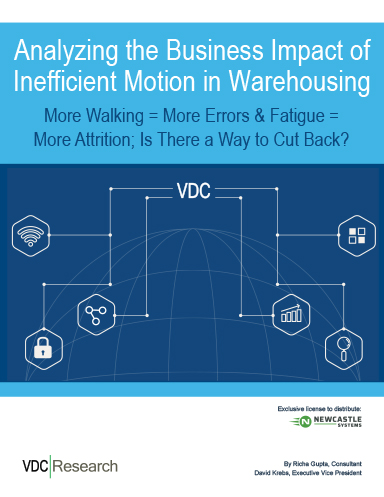How to Overcome Ergonomic Challenges in the Warehouse
Every seven seconds, a workplace injury takes place in the U.S., and the costs of these injuries can be catastrophic. In fact, warehouses and factories are considered some of the most dangerous places to work in this country. But the need for warehouse workers has never been greater.
While many warehouse injuries result from accidents, others are due to things like repetitive motion and overexertion.
There’s a good argument to be made for paying more attention to ergonomics in the warehouse. Here’s why you should do this and how warehouses can overcome various ergonomic challenges.
Why Ergonomics in the Warehouse Should Be a Priority
Warehouse ergonomics refers to having jobs and tasks fit to the worker instead of asking workers to force their bodies to fit the tasks. Ergonomics can help reduce workplace injuries by ensuring workers aren’t straining or performing too many repetitive motions. Here are several reasons why ergonomics in the warehouse should be a priority.
1. Better Quality of Work
Because ergonomics focuses on the efficiency of your systems, work quality is likely to increase. When ergonomics are poor, this can lead to frustrated and fatigued employees. A tired or injured worker may not be able to complete a task or won’t finish it according to your standards. A more ergonomically-designed warehouse allows workers to focus more on quality.
2. Improved Well-Being
When your employees’ needs in the workplace are given priority, they take notice. Employee engagement is a primary benefit of focusing on ergonomics. Your workers will feel more comfortable doing their jobs, and this will improve morale and reduce turnover. Better employee well-being is also vital to attracting new talent since workers looking for employment will be more likely to choose a company that cares about its employees.
3. Lower Costs
Another significant advantage of ergonomics is its ability to reduce costs. The primary way is through the reduction in workplace injuries. When your ergonomic changes help workers be more efficient and productive, you’ll be paying for fewer errors. Your business will also save costs with less employee turnover.
4. More Opportunities
Employers are required to provide accommodations to workers with specific needs. Ergonomics can help your warehouse meet these requirements as well as provide additional employment opportunities to people with limitations.
How to Overcome Ergonomic Challenges in the Warehouse
Muskuloskeletal and repetitive motion injuries in warehouses result in lost time from work, lower morale, reduced productivity, and high turnover. If your warehouse is impacted by incidents of strains, sprains, tears, and other injuries, it’s time to make ergonomics a priority. But, how should you approach this? Here are some proven strategies to overcome ergonomic challenges in the warehouse.
1. Store Items Strategically
Warehouse worker taking package in the shelf in a large warehouse in a large warehouseRepetitive lifting, awkward movements, and poor posture are common causes of employee injuries in the warehouse. Some changes in how and where you store products can impact the number of repetitive and potentially dangerous motions your workers must make in a shift.
Items that aren’t accessed often can be stored on low and high shelves, but frequently-accessed items should be placed at eye level to minimize movement. Also, keep size and weight in mind when considering storage spaces. Heavier objects should be placed below waist level to avoid worker strain when lifting.
2. Consider Material Substitutes
Warehouse work can be physically challenging, with worker fatigue being a significant hindrance to both productivity and safety. When employees are tired, they are going to sacrifice form by slouching and becoming more susceptible to sprains and strains.
If possible, see if the materials you are using can be substituted for something more worker-friendly. Provided it won’t damage products, using packaging envelopes might be lighter and easier to use than heavy boxes. It can also save your business some money.
3. Use Machine Assistance
If you want to make ergonomics a priority in your warehouse, identify areas where useful automation tools can help reduce worker fatigue and injuries. Some examples include:
- Bubble wrap dispensers that make it easier for workers to tear film needed
- Self-leveling lift tables that keep work at a comfortable level
- Order picking carts that eliminate the need to carry items
- Tilted pick trays that allow workers to view articles on elevated pallets
- Automated picking and packing solutions
- Wireless warehouse solutions that enable employees to work hands-free
4. Focus on Work Flow
Workplace safety begins with planning the flow of work to ensure that the environment is ideal for worker comfort and safety. Ideally, an employee’s workstation should be designed to minimize the travel and effort required for picking, scanning, weighing, labeling, packing, and routing products. Too much repetitive effort in these activities and travel can mean worker fatigue, injuries, and more human error.
See if you can group related tasks and develop a logical workflow that minimizes effort. Having workstations throughout the warehouse for the completion of tasks is better than a centralized point. For example, mobile computer workstations can travel around the warehouse and provide support for workers, reducing the amount of travel required between tasks.
5. Improve Employee Training
Ergonomics also involves training your workers on appropriate workplace safety practices. It’s a good idea to hire an ergonomics expert to teach a safety course to your employees. You can also have someone work with employees one-on-one to improve ergonomics. There should be regularly-scheduled training in the warehouse on things like proper lifting techniques and strain prevention to ensure compliance.
The emphasis of employee training should be on worker wellbeing and safety, not productivity. Display posters throughout the warehouse as reminders of the principles taught in employee training and have supervisors reinforce these ideas on the warehouse floor.
Warehouses are busy places. But being in a rush to get things done can mean you are asking workers to overexert their bodies, which invites injury and errors. When you find strategies to address ergonomic challenges in the warehouse, you’ll have a more productive and efficient operation, fewer injuries, and better overall results.
Related Resources
10 Tips to Improve Your Warehouse Receiving Process
Warehouse receiving processes can make or break a company's ability to service its customers. Download Now!
The Receiving Revolution: The Start of Something Big
Delays and errors in receiving foul your entire warehouse, slowing things down and lacing your shelves with mislabeled stock that’ll cause headaches for months to come. Download Now!
Analyzing the Business Impact of Inefficient Motion in Warehousing
More Walking = More Errors & Fatigue = More Attrition; Is There a Way to Cut Back. Download Now!
Article Topics
Newcastle Systems News & Resources
Efficiency Redefined: The Impact of Hybrid Automation in Warehouses Reverse logistics in need of some love To Double Worker Productivity, Roll Out These Mobile Powered Carts by Newcastle Systems Hybrid Automation Blends Technology and Human Labor for Optimal Efficiency How this 3PL Eliminated Costly Labeling Errors: Problem, Solution, & Results Inflation’s Impact on Warehousing and the Supply Chain 10 Tips to Improve Your Warehouse Receiving Process More Newcastle SystemsLatest in Technology
Happy Returns Partners With Shein and Forever 21 to Simplify Returns Frictionless Videocast: AI and Digital Supply Chains with SAP’s Darcy MacClaren The Top 10 Risks Facing Supply Chain Professionals Walmart’s Latest Service: Ultra Late-Night Delivery South Korea Finally Overtakes China in Goods Exported to U.S. SAP Unveils New AI-Driven Supply Chain Innovations U.S. Manufacturing is Growing but Employment Not Keeping Pace More Technology
















